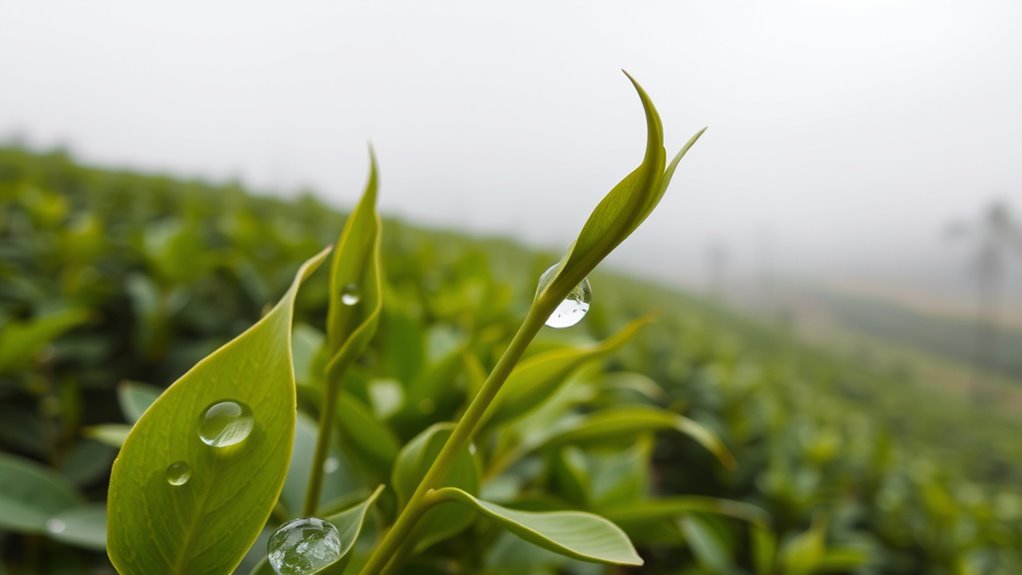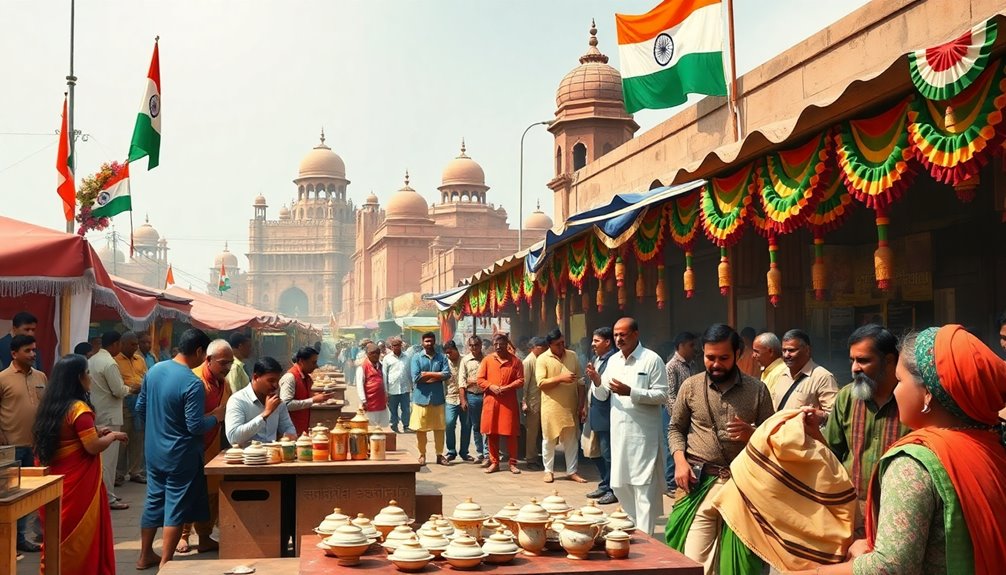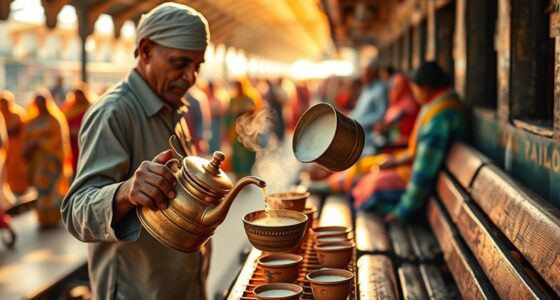The Indian monsoon greatly influences Assam tea quality by providing consistent rainfall, which guarantees healthy leaf growth and speeds up biochemical changes that develop rich flavors. Well-distributed monsoon rain promotes ideal leaf maturity, leading to strong aroma and flavor. Disruptions or irregular rainfall can cause uneven leaf development and increase pest or disease risks, affecting overall quality. To discover how these weather patterns shape each cup’s character, keep exploring the impact further.
Key Takeaways
- Consistent monsoon rainfall promotes uniform leaf growth, enhancing tea quality and flavor consistency.
- Steady rainfall accelerates biochemical changes in leaves, leading to richer aroma and taste profiles.
- Proper monsoon timing ensures optimal leaf maturity, critical for producing high-quality Assam tea.
- Adequate rainfall supports plant health, reducing pest and disease pressure that can affect tea quality.
- Disrupted monsoon patterns can cause uneven leaf development, negatively impacting flavor, aroma, and overall tea character.

The Indian monsoon plays a essential role in shaping the quality of Assam tea, directly impacting its flavor, aroma, and overall character. As the monsoon arrives, the rainfall patterns become a key factor in determining how the tea plants grow and develop. Consistent, well-distributed rainfall ensures that the tea bushes receive the moisture they need for ideal growth, leading to healthy, lush foliage. Conversely, irregular or insufficient rainfall can stress the plants, slowing down tea leaf maturation and potentially causing uneven plucking and lower quality leaves. The timing and intensity of monsoon rains influence not only the quantity of tea produced but also the subtle qualities that make Assam tea distinctive.
During the monsoon season, the increased rainfall accelerates the tea leaf maturation process. As the leaves absorb water, they undergo biochemical changes that enhance their flavor profile and aroma. This moisture-rich environment promotes the development of complex compounds within the leaves, which later translate into the rich, malty notes that Assam tea is famous for. When rainfall is ample and steady, the leaves mature uniformly, allowing tea producers to harvest high-quality leaves that have the ideal balance of strength and flavor. On the other hand, if the monsoon is weak or erratic, the leaves may mature unevenly, resulting in a mix of underdeveloped and overripe leaves. This inconsistency can compromise the overall quality, leading to a less refined taste and aroma.
Additionally, the pattern of rainfall influences the timing of the harvest season. Heavy monsoon showers may delay plucking, as the tea bushes need time to recover and produce tender, flavorful leaves. Conversely, a shorter monsoon might hasten the harvest period, impacting the depth of flavor that develops during the leaf maturation process. The right balance of rainfall ensures that the tea leaves reach their peak maturity, capturing the essential elements that give Assam tea its characteristic boldness and complexity.
Furthermore, the health of the monsoon season also affects the pest and disease pressure on tea plantations, which can influence leaf quality and overall yield. You’ll notice that the interplay between rainfall patterns and tea leaf maturation is a delicate dance. When the monsoon conditions are just right, they foster the growth of vibrant, aromatic leaves that translate into premium-quality Assam tea. Any disruption in this balance, whether through irregular rainfall or drought, affects the entire process—from leaf development to final flavor. In essence, the health of the monsoon season directly shapes the quality of every cup, making it a crucial factor for tea farmers and connoisseurs alike.
Frequently Asked Questions
How Does Monsoon Variability Affect Assam Tea Harvest Timing?
You notice that monsoon timing directly impacts your Assam tea harvest scheduling. When monsoon arrives early or late, it alters the growth cycle of tea plants, prompting you to adjust your harvest timing accordingly. Variability in monsoon patterns can cause delays or early starts, making it vital for you to monitor weather closely. By staying adaptable, you guarantee ideal tea quality despite unpredictable monsoon influences on your harvest schedule.
What Role Do Local Microclimates Play in Tea Quality During Monsoon?
You’ll find that local microclimates markedly influence tea quality during the monsoon. Microclimate effects, like humidity, temperature, and shade, create unique terroir influence that shapes leaf flavor and aroma. When you understand these microclimates, you can better appreciate how specific conditions enhance or diminish tea characteristics. This nuanced interplay makes each estate’s tea distinct, showcasing how microclimates and terroir influence the final product during the monsoon season.
Are There Specific Monsoon Patterns Linked to Higher-Quality Assam Tea?
You wonder if certain monsoon patterns boost Assam tea quality. Strong monsoon intensity, balanced rainfall distribution, and consistent timing tend to produce better leaves. When the monsoon is too intense or irregular, it can harm the tea. Conversely, moderate, well-distributed rainfall nurtures the tea plants, enhancing flavor and aroma. In short, stable monsoon patterns with ideal intensity and rainfall distribution are linked to higher-quality Assam tea.
How Do Farmers Adapt to Changing Monsoon Conditions for Optimal Tea Quality?
You adapt to changing monsoon conditions by implementing pest management strategies to protect your tea plants from seasonal pests. You also focus on maintaining soil fertility through organic compost and timely fertilization, ensuring your plants stay healthy despite unpredictable rains. These practices help you optimize tea quality by reducing stress on the plants and promoting steady growth, even when monsoon patterns fluctuate.
What Are the Long-Term Impacts of Monsoon Shifts on Assam’s Tea Industry?
Like a ship steering shifting seas, your tea industry faces long-term impacts from monsoon shifts. These changes threaten climate resilience, causing unpredictable harvests and quality fluctuations. To adapt, you should focus on crop diversification, reducing dependency on traditional methods. This strategy strengthens your resilience, ensuring sustainable growth despite climate uncertainties. Embracing these approaches helps safeguard Assam’s tea heritage for future generations.
Conclusion
As you savor a cup of Assam tea, remember that the monsoon’s gentle touch shapes its rich aroma and bold flavor. Like a master artist, the monsoon paints the landscape with moisture, directly influencing tea quality. Without its nurturing presence, the brew would lack its signature character. So, next time you sip, realize you’re experiencing nature’s symphony—an intricate dance between climate and craftsmanship that elevates every drop. Truly, the monsoon’s influence is the heart of Assam’s cherished tea.










